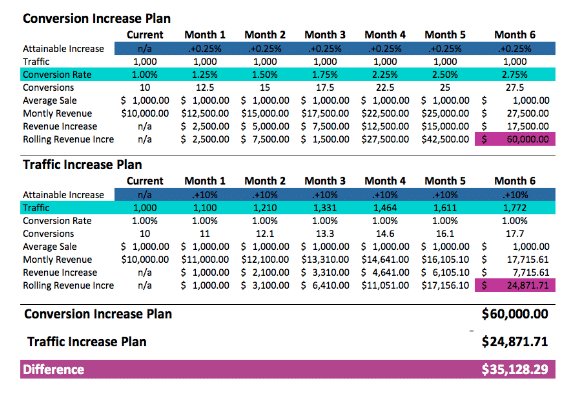Hinweis: Dies ist ein Gastbeitrag von Malaika Nicholas, der Content-Marketing-Strategin bei Ladder über das Thema Click Through Rate. Alle in diesem Beitrag geäußerten Meinungen sind die von Malaika.
Was ist die Click-Through-Rate?
Die Click-Through-Rate (CTR), oder auch Klickrate, ist eine Kennzahl, die als Prozentsatz angezeigt wird und angibt, wie viele Personen auf Ihre Anzeige geklickt haben, um eine Website oder Landing Page zu besuchen.
Warum sind Klickraten wichtig?
Bei bezahlten Anzeigen auf Facebook, Google AdWords und anderen Werbeplattformen wirkt sich die Klickrate direkt auf den Qualitätswert oder den Relevanzwert einer Anzeige aus.
Kostenlos herunterladen: Leitfaden zur Optimierung der Conversion Rate
Beachten Sie jedoch, dass hohe Klickraten nicht immer ein positives Zeichen sind. Wenn Ihre Anzeige nicht auf die richtigen Keywords abzielt oder Ihr Anzeigentext, Ihre Landing Page oder Ihr Angebot nicht hilfreich oder relevant für die Nutzer ist, geben Sie möglicherweise viel Geld für Anzeigen aus, die sich nicht auf Ihr Endergebnis auswirken. Entscheidend ist, dass Sie jedes Element testen, das Ihnen Conversions bringen soll.

Investieren Sie Zeit in die Keyword-Recherche, um sicherzustellen, dass jede bezahlte Anzeige für Ihre idealen Kunden oder Ihre Zielgruppe relevant ist.
Wie lautet die Formel zur Berechnung von Klickraten?
Um die Klickrate für eine bezahlte Anzeige zu berechnen, teilen Sie die Gesamtzahl der Klicks auf die Anzeige durch die Gesamtzahl der Impressionen (d. h. die Gesamtzahl der Personen, die die Anzeige gesehen haben).
Nehmen wir zum Beispiel an, dass Ihre Anzeige 100 Klicks generiert und während der Kampagne von 2.000 Personen gesehen wurde.
CTR = 100 (Klicks) ÷ 2.000 (Impressionen) = 0,05 x 100 (Prozent) = 5% CTR
Profi-Tipp: Vergessen Sie nicht, Ihr Ergebnis mit 100 zu multiplizieren, um zusätzliche Zeit bei der Berechnung des Prozentsatzes zu sparen.
Die Berechnung von Klickraten ist nicht auf Performance-Marketing-Kanäle wie Google Ads beschränkt.
Angenommen, ich möchte wissen, wie viele Leute die Homepage meiner Website besuchen, nachdem sie einen meiner Blogbeiträge gelesen haben.
In diesem Fall schaue ich mir die Klickrate an, die mir sagt, wie viele Besucher den Link zu meiner Website in meinem Blogbeitrag angeklickt haben, gemessen an der Gesamtzahl der Besucher des Blogbeitrags.
Personen, die auf die Website eines Blogbeitrags klicken / Gesamtzahl der Blogbeitragsbesucher x 100 = Klickrate
Aber was ist mit der Conversion Rate aus und wie verhält sie sich zu den Klickraten?
Was ist die Conversion Rate?
Die Conversion Rate ist eine Kennzahl, die in Prozent anzeigt, wie viele Website- und App-Besucher eine Aktion im Verhältnis zur Gesamtzahl der Besucher durchführen.
Warum sind Conversion Rates wichtig?
Für viele Marketer und Unternehmer sind die Conversion Rates die wichtigste Kennzahl, die sie regelmäßig überwachen müssen, da sie sich direkt auf den Gesamtumsatz und die Einnahmen ihres Unternehmens auswirken.
Chris Keller von Bizible unterstreicht diese Idee indem er 3 Gründe nennt, warum Website-Conversions wichtiger sind als Web-Traffic.
Erstens argumentiert Keller, dass ein höherer Traffic nicht zwangsläufig zu einer Umsatzsteigerung führt.
Dies kann verschiedene Ursachen haben:
- Sie ziehen eine ungeeignete Zielgruppe an, da Sie die falschen Keywords verwenden
- Website-Inhalte, die keinen Bezug zu Ihren Produkten und Dienstleistungen haben
- Fehlerhafte Lead-Gen-Formulare oder Conversion Flows
Zweitens argumentiert Keller, dass es wesentlich einfacher ist und weniger Zeit in Anspruch nimmt, die Conversion Rate im Internet zu erhöhen, als den Internet-Traffic zu steigern.
Deshalb ist es wichtig, die Kunst des Conversion Marketing zu beherrschen.Der letzte Punkt, den Keller anführt, besteht in der Priorisierung von CRO (Conversion Rate Optimization) vor der Optimierung des Web-Traffics – und nicht umgekehrt – da es einen größeren Einfluss auf den ROI und die Rentabilität Ihres Unternehmens hat.


Wie wird die Conversion Rate berechnet?
Um die Conversion Rate zu berechnen, teilen Sie die Gesamtzahl der Besucher Ihrer Website oder Landing Page durch die Anzahl der abgeschlossenen Zielaktionen.
Pro-Tipp: Sie können dieses Ergebnis mit 100 multiplizieren, um bei der Berechnung des Prozentsatzes etwas Zeit zu sparen.
Es ist jedoch wichtig zu beachten, dass sich diese Formel je nach Art der gemessenen Umsätze leicht ändert.
Wenn Sie z. B. die Conversion Rate der Besucher Ihrer Website messen, die zu Leads werden, lautet die Formel:
- Gesamtzahl der gesammelten Leads / Gesamttraffic auf der Website x 100 = Conversion Rate
Wenn ich berechnen möchte, wie viele Website-Besucher in zahlende Kunden umgewandelt werden, sieht die Formel für die Conversion Rate wie folgt aus:
- Anzahl der Verkäufe / Gesamttraffic auf der Website x 100 = Conversion Rate
Wenn ich schließlich messen möchte, wie viele Personen meinen Newsletter abonniert haben, nachdem sie auf meine Anzeige geklickt haben, wird die Formel für die Conversion Rate wie folgt geändert:
Anzahl der Personen, die meinen Newsletter abonnieren / Gesamtzahl der Personen, die meine Anzeige angeklickt haben x 100 = Conversion Rate
Kostenlos herunterladen: Leitfaden zur Optimierung der Conversion Rate
Google-Analytics-Tools zum Tracken von Conversion Rates und Klickraten
Google Analytics ist ein unglaublich vielseitiges Tool, mit dem Sie herausfinden können, wer Ihre Zielgruppe ist, wie es sich auf Ihrer Website verhält (Sie können auch in Google Analytics Heatmaps erstellen), wo es sich über Ihr Unternehmen informiert (d. h. über die Traffic-Quellen) und wie es mit dem Inhalt Ihrer Website interagiert.
Insbesondere können Sie mit Google Analytics bestimmte Ziele einrichten, mit denen Sie nachverfolgen können, wenn auf Ihrer Website eine bestimmte Aktion durchgeführt wird (Conversion Rate), z.B. das Absenden eines Formulars oder der Kauf eines Produkts.
Schauen Sie sich dieses kurze Video von Google an, in dem erklärt wird, wie Sie Ziele in Google Analytics verwenden, um Ihre Conversion Rates zu verfolgen.
Sie können Google Analytics auch verwenden, um Impressionen und die Click-Through-Rate Ihrer Google AdWords-Kampagnen zu verfolgen. Hier ist ein kurzes Video, das erklärt, wie es funktioniert.
Zusätzlich zu Google Analytics können Sie eine der folgenden Möglichkeiten nutzen, um Conversion Rates und/oder Click-Through Rates zu verfolgen.
- Native Werbeplattformen (Facebook Ads Manager, Twitter Ads Manager, Google AdWords Manager Accounts)
- Analysesoftware von Drittanbietern (Tableau, Funnel.io, Mixpanel)
- Tools zur Optimierung der Conversion Rate CRO (VWO)

Conversion Rate vs. Klickrate: Welche Rate sollten Sie messen?
Digitale Marketer sollten letztlich sowohl die Conversion Rate als auch die Klickrate nutzen, um den Erfolg ihrer Marketingmaßnahmen zu messen.
Wie Andrew Chu von MGX Copy jedoch feststellt, betreffen die Klickraten und die Conversion Rates zwei unterschiedliche Marketing-/Verkaufsfunnelstufen.
Am Anfang des Verkaufsfunnels misst die Klickrate, welche Aktion die Nutzer durchführen (z. B. auf Ihre Anzeige klicken), bevor sie auf Ihre Website gelangen.In der Mitte und am unteren Ende des Verkaufsfunnels (MOFU/BOFU) messen die Conversion Rates die Aktionen, die die Besucher durchführen, wenn sie bereits auf Ihrer Website sind.
Zum Beispiel:
– Formular-Einsendungen
– E-book-Downloads
– Produktkäufe
Und mehr…
Nehmen wir an, ich möchte wissen, wie viele Personen meine Website besucht haben, nachdem sie meine Facebook-Anzeige gesehen haben. In diesem Fall würde ich die Klickrate ermitteln wollen.
Wenn meine Facebook-Werbeanzeige 100.000 Mal aufgerufen wurde und 3.500 dieser Personen auf meine Anzeige klickten, um meine Website zu besuchen, beträgt meine Klickrate 3,5%.
Gar nicht so schlecht!
Angenommen, ich möchte wissen, wie viele Personen von denjenigen, die auf meine Facebook-Anzeige geklickt haben, zu Abonnenten des E-Mail-Newsletters wurden. In diesem Fall möchte ich die Conversion Rate messen.
Hier haben von den 3.500 Personen, die auf meine Facebook-Anzeige geklickt und meine Website besucht haben, 40 Personen meinen E-Mail-Newsletter abonniert, was einer Conversion Rate von 1,14% entspricht.

Welche Kennzahl sollten Sie also messen: die Conversion Rate oder die Klickrate?
Die Antwort hängt davon ab, welche Phase im Marketing-/Verkaufsfunnel Sie optimieren möchten.
Wenn Sie Ihr Keyword-Ranking in den SERPs verbessern oder den Traffic auf Ihrem Blog erhöhen möchten, ist die Messung und Optimierung Ihrer Klickrate ideal.
Wenn Sie sich auf den Ausbau Ihrer E-Mail-Newsletter-Abonnentenliste, die Erhöhung der Anzahl der Personen, die sich für eine kostenlose Testversion anmelden, oder die Steigerung der Anzahl der Produkte, die Sie online verkaufen, konzentrieren möchten, dann sollten Sie sich auf die Messung und Optimierung der Conversion Rates Ihrer Website konzentrieren.
6 umsetzbare Wachstumstaktiken zur Verbesserung der Klickraten
Hier sind ein paar schnelle Tipps, die Ihnen helfen, Ihre Klickraten zu verbessern:
- Führen Sie eine Verbraucherstudie über Ihre Zielgruppe durch. Dies wird Ihnen ein besseres Verständnis dafür vermitteln, auf welche Art von Botschaften Ihre Zielgruppe am ehesten reagieren wird
- Verwenden Sie Keyword-Recherche-Tools, um bestimmte Begriffe zu finden, nach denen Ihre Zielgruppe sucht. Beziehen Sie auch negative Keywords und Marken-Keywords in Ihre Recherche ein
- Schreiben Sie eine Anzeige, die verlockend ist und Ihre Marke hervorhebt. Verwenden Sie aussagekräftige Wörter, die Dringlichkeit, Autorität, Performance, fortschrittliche Technologie, Knappheit oder sozialen Beweis vermitteln.
- Verwenden Sie hochwertige, auffällige Fotos in Ihren Anzeigen; achten Sie jedoch darauf, dass Ihre Bilder nicht mehr als 20% des überlagerten Textes enthalten.
- Vergewissern Sie sich, dass der Text, der Inhalt und das Design Ihrer Landing Pages auf Ihre bezahlten Anzeigen abgestimmt sind.
- Eine klare und prägnante Handlungsaufforderung, die dem Betrachter deutlich macht, was er nach dem Anklicken Ihrer Anzeige erwarten kann
Ausführlichere Informationen zu diesen Tipps finden Sie in diesen hilfreichen Ressourcen:
Google AdWords-Tipps zur Erstellung von hochgradig konvertierenden Suchanzeigen
Umsetzbare Wachstumstaktiken zur Verbesserung der Conversion Rates
Bei der Optimierung der Conversion Rate geht es darum, verschiedene Berührungspunkte auf der mittleren und unteren Ebene des Marketing-/Verkaufsfunnels zu identifizieren, zu analysieren, zu testen und zu verbessern. Hier sind ein paar schnelle Tipps, wie Sie Ihre Conversion Rates optimieren können.
- Personalisierung Ihrer Nachrichten und Benutzererfahrungen, basierend auf dem Besucherverhalten, den Vorlieben oder Interessen
- Geben Sie Website-Besucher, die nicht sofort konvertieren, nicht auf. Halten Sie sie mit Retargeting-Anzeigen bei der Stange. Hier können Sie Dienstleistungen, Produkte oder Angebote anzeigen, die auf dem Interesse der Besucher basieren.
- Bieten Sie Kundenunterstützung während des gesamten Kaufzyklus an. Sie können einen Echtzeit-Chat mit einem Kundenbetreuer anbieten, im Help Center Informations-Tutorials und Informationen zur Fehlerbehebung bereitstellen oder Fragen der Besucher auf einer speziellen FAQ-Seite beantworten
- Verwandeln Sie Website-Besucher in potenzielle Interessenten, indem Sie ihnen im Tausch gegen ihre Kontaktinformationen kostenlose Materialien anbieten. Sie können zum Beispiel ein technisches Whitepaper, ein E-Book mit Anleitungen, datenreiche Infografiken oder exklusive Videoinhalte anbieten
- Geben Sie den Besuchern Ihrer Website mehrere Gelegenheiten zur Konvertierung. Die Wahrscheinlichkeit, dass jemand Ihre Website zum ersten Mal besucht und sich sofort für einen Kauf entscheidet, ist gering. Geben Sie zögernden Besuchern stattdessen zusätzliche Konversionsmöglichkeiten (auch bekannt als „MikroConversions“), wie z. B. die Möglichkeit, sich über eine intelligente Leiste in Ihre E-Mail-Liste einzutragen, ein zeitlich begrenztes Angebot in einem Exit-Intent-Pop-up anzuzeigen oder ihnen die Möglichkeit zu geben, einen Webbrowser und mobile Push-Benachrichtigungen für die neuesten Updates zu abonnieren.
- A/B-Tests für verschiedene Elemente Ihrer Landing Pages, darunter Hero-Bilder, Call-to-Actions, Taglines, Beschreibungen, die Positionierung von Schaltflächen, das Format von Kontaktformularen und andere.
- Fügen Sie Social Proof auf beliebten Landing Pages hinzu. Versuchen Sie, Ihrer Website und Ihren Landing Pages Kundenreferenzen, bekannte Marken, mit denen Sie zusammengearbeitet haben, oder Bewertungen und Rezensionen von mobilen App-Stores hinzuzufügen.
Um die Conversion Rates Ihrer Website weiter zu steigern, lesen Sie diesen Artikel über Leadmagnete. Leadmagnete oder Content-Upgrades können eine großartige Ergänzung zu Ihrer Gesamtstrategie zur Optimierung der Conversion Rate sein.





















